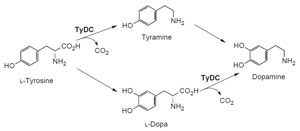Tetrahydrobenzylisoquinoline Alkaloids
The opium poppy P. somniferum contains more than 80 tetrahydrobenzylisoquinoline- derived alkaloids. It is the source of the narcotic analgesics codeine and morphine. P. somniferum is one of mankind’s oldest medicinal plants, and the plant as we know it today is the result of centuries of breeding. Our biochemical and molecular genetic knowledge of P. somniferum is relatively advanced. We understand how morphine is enzymatically formed and cDNAs encoding the enzymes occurring mainly downstream of formation of the first alkaloid in the pathway, (S)-norcoclaurine, have been isolated (Kutchan, 1998). Our current understanding of alkaloid biosynthesis in P. somniferum is as follows. |
| FIGURE 10.5 Schematic representation of the biosynthetic grid leading from L-tyrosine to dopamine. tydc, tyrosine/dopa decarboxylase. |




